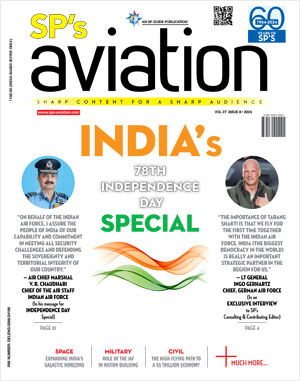INDIAN ARMED FORCES CHIEFS ON OUR RELENTLESS AND FOCUSED PUBLISHING EFFORTS

SP Guide Publications puts forth a well compiled articulation of issues, pursuits and accomplishments of the Indian Army, over the years

"Over the past 60 years, the growth of SP Guide Publications has mirrored the rising stature of Indian Navy. Its well-researched and informative magazines on Defence and Aerospace sector have served to shape an educated opinion of our military personnel, policy makers and the public alike. I wish SP's Publication team continued success, fair winds and following seas in all future endeavour!"

Since, its inception in 1964, SP Guide Publications has consistently demonstrated commitment to high-quality journalism in the aerospace and defence sectors, earning a well-deserved reputation as Asia's largest media house in this domain. I wish SP Guide Publications continued success in its pursuit of excellence.
Draft Map Policy What about defence and security?
 |
By Lt. General P.C. Katoch Former Director General of Information Systems, Indian Army |
The MHA has released the draft Geospatial Information Regulation Bill 2016, which open to public for comments till June 03. Under this bill, government Centre will set up Security Vetting Authority (SVA) whose permission will be needed for acquiring maps, geospatial data though space or aerial platforms (satellite, aircraft, balloons, UAVs, terrestrial vehicles) or any other means. It says publishing or sharing “illegal” maps would invite fines up to 100 crore and / or a seven-year jail term. What prompted the bill were instances of social networking sites like Twitter showing Kashmir in China and Jammu in Pakistan, which was corrected after Indian government protests. Some other maps on social networking sites showed J&K and Arunachal Pradesh part of Pakistan and China respectively. The draft bill will ensure that online platforms like Google will have to apply for a license to run Google Maps or Google Earth in India.
At the same time, according to the draft bill, it will be mandatory to take permission from a government authority before acquiring, disseminating, publishing or distributing “any geospatial information of India”. Such wording lends itself to ambiguity and confusion. Internet and public policy experts have criticized the proposed legislation for its vague wording and harsh penalties and feel it could adversely affect doing business. Many feel that sharing geospatial information could even mean location coordinates and the bill could create a license-permit raj. Publishing illegal maps of India is one thing and exchanging geospatial information another, especially in this age of digitization.
Military and security forces are doing so on daily basis and so would intelligence agencies and those in the civil especially during business transactions. Besides, what happens if Twitter or Google want to show illegal Indian maps captioned as shown by China / Pakistan as the case may be. Can the caption be made mandatory or we want these blocked altogether so we don’t know what propaganda our adversaries are up to? What of a Chinaman or Pakistani subscriber of Twitter or other social media puts up such map? What about countries who are publishing “illegal” maps of India? China, Japan, even USA? What action do we contemplate in such instances? How many of us are aware that in 1967, the US Defense Mapping Agency began to show India-Pak boundary on Tactical Pilotage Charts as proceeding from NJ 9842 east-northeast to the KK Pass on the China border without justification / documentation, cartographically giving entire Siachen-Saltoro area to Pakistan. Deliberate US mischief or not but many official-private cartographers and atlas producers followed suit and Pakistan thenceforth claimed this as boundary.
Are we going to sue atlas producers in such future eventuality? What about the National Map Policy 2005 (in cold storage past 15 years despite implications for defence and security) which defines two series of incompatible maps; Defence Series Maps (DSM) based on WGS 84 / LCC and Open Series Maps (OSM) based on WGS 84 / UTM. There is no mention anywhere of the elevation system to be used whether it should be WGS 84 or another. Moreover, the policy does not cover the nautical and aeronautical charts. The policy is restricted to small scale maps and is silent on responsibility for attribute collection. The overall implications are that we have two incompatible projections and associated different grids that are an operational nightmare. Similarly, under the Remote Sensing Data Policy 2011, the National Remote Sensing Centre (NRSC) is vested with the authority to acquire and disseminate remote sensing data. All data of resolutions up to one metre is distributed on a non-discriminatory basis.
All data better than one metre resolution is to be screened and cleared by appropriate agency prior to distribution. This policy also talks of specific sales / non-disclosure agreements for data better than one metre resolution. The implications are it places undue restrictions on genuine users (more license raj) for the simple reason that point five resolution data is available in the public domain through Google Earth etc. We need to take a holistic view of geospatial intelligence and make laws that are practical, implementable and not binding the user unnecessarily.
The views expressed herein are the personal views of the author.





